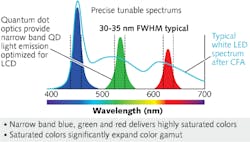Quantum dots (QDs) are already found in most segments of the display market, with many tablets, laptops, monitors, and televisions using QDs within the liquid-crystal-display (LCD) backlight unit. The white-light LED backlight source is replaced with a simpler-to-produce blue LED, a portion of which is then downconverted using QDs into red and green narrowband emission peaks, resulting in an LCD gamut that is enhanced by roughly 50%. QD Vision (Lexington, MA) supplies QDs in a tube at the edge of the LCD (for >20 in. edge-lit displays).
Because emission from QDs is tunable, manufacturers can choose how they want to balance display brightness and color performance. For 100% National Television System Committee (NTSC) full-color-gamut products, a small decrease in brightness is measured when using quantum dots; however, this decrease is more than compensated by the Helmholtz–Kohlrausch (H-K) effect, which shows that we perceive saturated colors more brightly than muted, unsaturated colors. If optimizing for efficiency, gamut gains of 20% can be achieved. In all cases, the cost of adding QDs to an LCD is much less than the cost of switching to OLED technology. Contact Seth Coe-Sullivan at[email protected].
